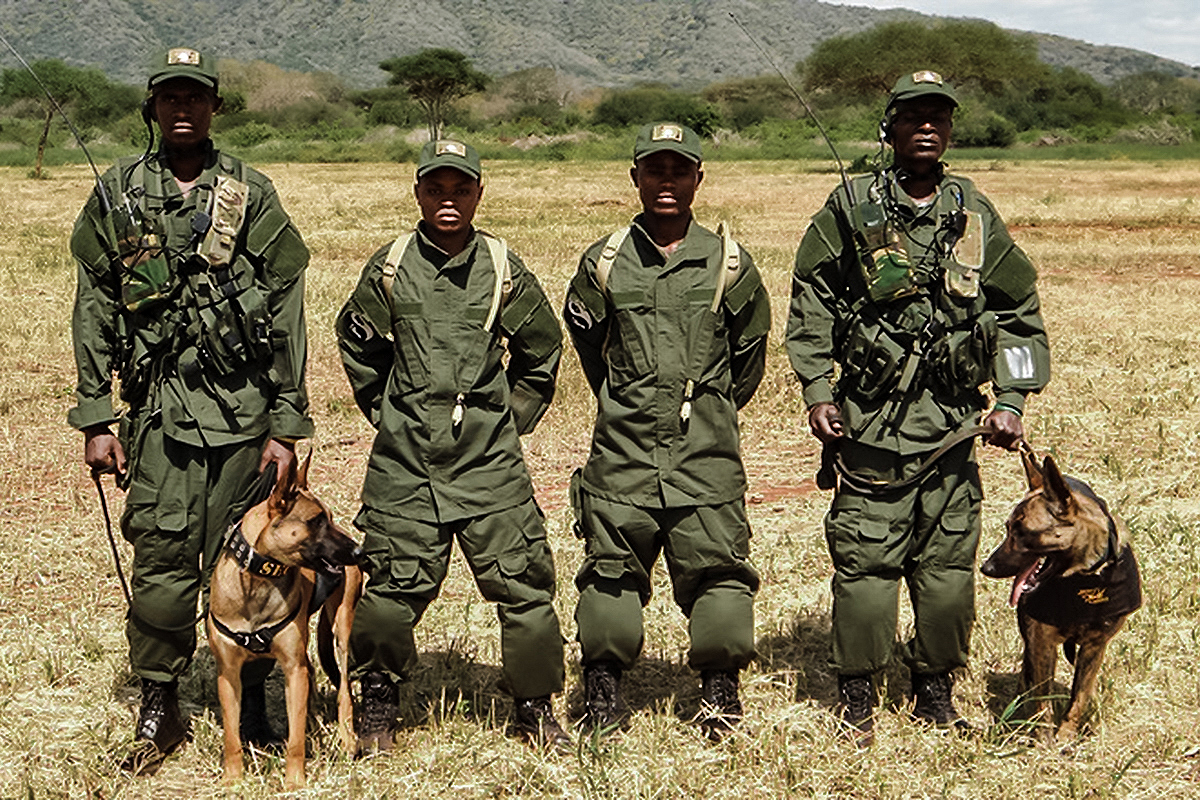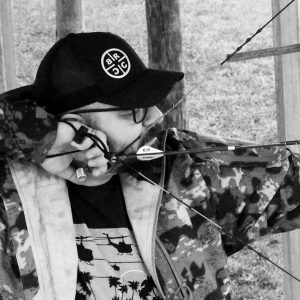Experts say rhinos are teetering on the brink of extinction, with 27,000 of the animals left on the entire planet. In Africa, the stakes are life and death for people defending their homeland by battling rhino poachers who would kill the few remaining animals for their increasingly valuable horns. They’ll take any advantage they can get, and it turns out, one of the most useful weapons they have in the fight against poachers comes on four legs.
Human beings have been teaming up with canines since prehistoric times. We use them to alert us to prey or danger with their far better senses, which also let them be our trackers. Plus, their teeth, claws, and loyalty make them our defenders when necessary. And they use us for our thumbs and our ability to make heat in the cold. For the past several years, they’ve also been used to track down and capture poachers in several African countries on a mission similar to that of US military K-9s.
For 10 years now, the Anti-Poaching Tracking Specialists (ATS) team in Zimbabwe has been using dogs to kick the shit out of poachers going after black and white rhinos in the country’s Savé Valey Conservancy. The ATS K-9 unit has cracked dozens of rhino poaching syndicates in that time, which has resulted in a cumulative 189 years in prison sentences handed down to poachers, according to this story from MSN News.
The conservancy is located in the southeastern lowveld of Zimbabwe and is one of the largest private game reserves in Africa, covering over 1,150 square miles (that’s about 100 square miles bigger than Rhode Island and just a big smaller than Delaware).
ATS operations resulted in the arrests of 29 rhino poachers in the past four years alone, the story says. The team’s lead K-9 handler, Mathius Mbengo, and his Belgian Malinois partner have apprehended four rhino poaching gangs in that time. The article profiles Mbengo’s grueling workday as he and his K-9 partner cover about 15.5 miles a day on foot, chasing down poachers.
RELATED – LOL: Oregon Poaching Ring Done-in by Text Messages
The ATS K-9 unit consists of 11 Belgian Malinois dogs and their handlers, and, according to Andrew Campbell, director of the Game Rangers Association of Africa, the unit is “one of the most active and results-oriented rhino anti-poaching organizations in Southern Africa and certainly in Zimbabwe.”
The anti-poaching dogs pull some of the same duties as law enforcement K-9s in the US and military dogs. Namely, they are used to run down poachers in open country or in hiding spots and hold them until their handlers arrive, and tear them up a little if necessary. They’re also used for tracking poachers through the African bush and running them down over significant distances.
The Belgian Malinois is a hearty breed that gained prominence when a Belgian on SEAL Team 6 took down Osama Bin Laden in 2011. The Malinois is one of four types of Belgian Shepherd, aka Belgian Sheepdog. They are all medium-sized herding dogs that come in four distinct varieties based on coat type and color. There’s the long-haired black Groenendael, the rough-haired fawn Laekenois, the long-haired fawn Tervuren, and the short-haired fawn Malinois. In the US, they are each considered separate breeds.
They come from the shepherd dogs that worked the fields of Western Europe for centuries that also produced the German Shepherd. The Belgian breed was standardized in the late 19th century, and, in addition to herding, they have been widely used as assistance dogs, companions, detection dogs, guard dogs, guide dogs, police dogs, and search and rescue dogs. They have a long history of military service in both World Wars right up to the present day.
Zimbabwe is currently home to about 1,000 rhinos; the population was decimated by poachers about 30 years ago, leading to the creation of anti-poaching organizations like ATS.
At the top of the 20th century, there were 500,000 rhinos in Africa and Asia, according to the World Wildlife Foundation. By 1970, there were about 70,000 left, and numbers have continued to dwindle.
The Savé Valey Conservancy is also home to protected species like elephants, pangolins, painted dogs, cheetahs, lions, sables, pythons, ground hornbills, and lappet-faced vultures, in addition to 25% of the country’s black rhinos. It’s one of three Intensive Protected Areas in Zimbabwe for rhinos and one of nine in all of Africa, making it an important battleground for the species’ survival and in the fight against wildlife crime.
RELATED – Prison for Man Who Illegally Trapped Thousands of Turtles for Pet Trade
“In 2009, there was a nationwide rhino-poaching surge,” said Nicholas Duncan, president and co-founder of the Save African Rhino Foundation. The Australia-based organization has been working in the area for 35 years.
“In particular, the Savé Valley Conservancy in the south of the country was under immense rhino poaching pressure, and this went on for some time,” Duncan added. “In 2012, we brought ATS into the region for a three-month assessment of the situation, to try to put some systems in place and find the gaps. And the team has been on the ground, holding the security ever since.”
Since the ATS and its K-9 unit got there, the rhino population in the conservancy has seen a growth of 7%. The IUCN recommends a 5% growth rate for rhino reserves. Additionally, the ATS has maintained a poaching mortality rate under the recommended rate of 2%.
While the efforts of the ATS are noteworthy, they have not been able to irradicate poachers chasing rhino horns.
Rhino horns are used in traditional Chinese medicine and for other purposes in a range of Asian countries, according to the International Anti-Poaching Foundation (IAPF).
The organization says a rhino’s horn, which is not attached to the animal’s skull and grows throughout its life, consists of keratin, the same material found in cockatoo bills, turtle beaks, and horses’ hooves, along with amino acids like cysteine, arginine, lysine, tyrosine, and histidine and salts such as calcium phosphate and calcium carbonate.
In traditional Chinese medicine, the horn has been used to treat everything from gout and hangovers to food poisoning and typhoid. It is typically ground into a fine powder and dissolved in boiling water before being consumed. As you may have guessed, there is no proof that rhino horn has any medicinal value of any kind — but that doesn’t stop people from believing that it does.
While the legal medicinal use of rhino horn has been banned since 1993, there is still a black market for the substance, and poaching is an ongoing problem, and sometimes, the poachers win. In February 2022, a pregnant white rhino cow was killed for its horn by poachers in the conservancy.
Until the demand for rhino horn is eliminated, it looks like the poacher hunters in the African and Asian nations that harbor the remaining animals, and their K-9 partners, will regrettably have plenty of work to do.
READ NEXT – Zambian War on Wildlife Poaching Captured by Montana Filmmakers








Comments